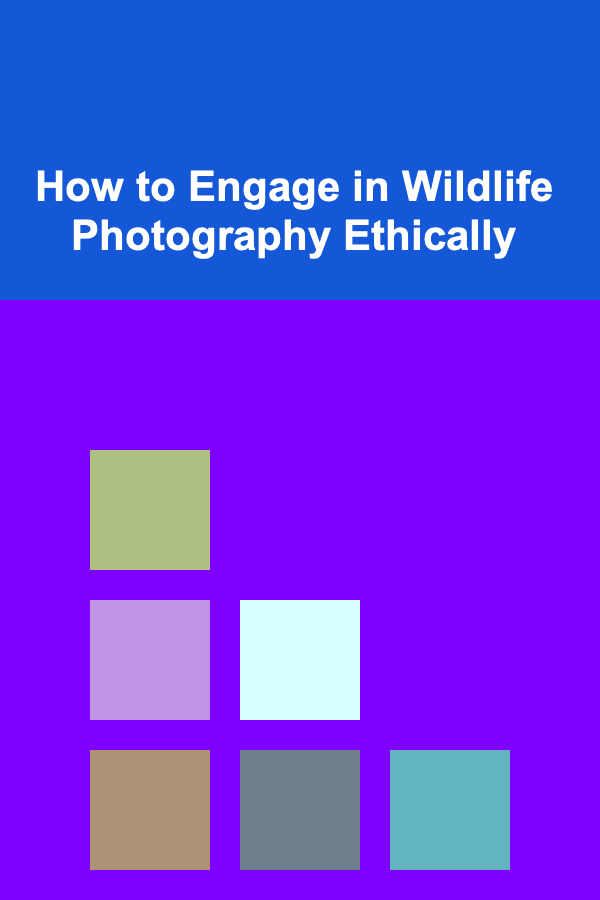
How to Engage in Wildlife Photography Ethically
ebook include PDF & Audio bundle (Micro Guide)
$12.99$6.99
Limited Time Offer! Order within the next:

Wildlife photography is a captivating art form that allows photographers to capture the beauty, behavior, and struggles of animals in their natural habitats. However, it is crucial to approach wildlife photography with an ethical mindset to ensure that our interactions with animals do not harm them or disrupt their ecosystems. As our relationship with nature evolves, ethical considerations in wildlife photography have become more important than ever. This article delves into the ethical principles and guidelines that photographers should follow when engaging in wildlife photography.
Understanding the Ethical Framework in Wildlife Photography
Ethical wildlife photography is rooted in the idea that photographers have a responsibility to preserve the integrity of the natural world and the well-being of the animals they capture. The goal of ethical wildlife photography is not only to create beautiful images but also to respect wildlife and contribute to its conservation. Here are the key principles that underpin ethical wildlife photography:
a. Respect for Wildlife
Respect for wildlife is the foundation of ethical wildlife photography. Animals, like humans, deserve to live without unnecessary disturbance or harm. Photographers should always keep the welfare of the animals in mind and avoid actions that could stress or alter their natural behavior. This means refraining from behaviors that disturb the animals' routines, habitats, or physical well-being.
b. Conservation Awareness
Wildlife photography should raise awareness about the plight of animals and the importance of conserving their habitats. Ethical photographers use their images to educate the public about biodiversity, conservation efforts, and the environmental challenges that wildlife faces. Photographers should avoid exploiting animals for commercial gain and instead strive to promote conservation through responsible and impactful photography.
c. Impact Minimization
An ethical photographer should minimize their environmental impact. This includes ensuring that their presence does not disturb the habitat, cause erosion, or damage plants or other elements of the ecosystem. Photographers should be mindful of their footprint on the environment and take steps to mitigate their impact, whether it be through careful navigation of trails or using sustainable equipment.
d. Avoiding Manipulation of Wildlife
Manipulating animals for the sake of a photo is not only unethical but can be dangerous to both the animal and the photographer. This includes actions such as baiting animals, encouraging unnatural behaviors, or using props to attract animals into an unnatural setting. The focus should be on documenting the natural world as it is, without artificially altering it to create a specific image.
Best Practices for Ethical Wildlife Photography
a. Prioritize Animal Welfare
The health and safety of the animals you photograph should always be your top priority. You should never place an animal in a situation where it feels threatened or uncomfortable. Common practices that can be harmful to animals include:
- Getting too close: Wild animals often experience stress when humans approach too closely. It is essential to maintain a safe distance and use a long lens to avoid disturbing the animal's behavior.
- Interfering with natural behavior: Avoid actions that might alter the animal's natural behavior. For example, don't try to lead animals to a specific spot or use food to attract them, as this can disrupt their normal routines and feeding habits.
- Using flash photography: Flash can cause distress to animals, especially those with sensitive eyes or nocturnal habits. Always avoid using flash and rely on natural lighting whenever possible.
b. Research and Preparation
Before setting out to capture images of wildlife, it's essential to thoroughly research the species you're photographing and the location you'll be working in. Each animal species has its own behaviors, patterns, and sensitivities to human presence. By learning about these nuances, you can make informed decisions about how to approach the photography session ethically.
For example, if you're planning to photograph nesting birds, it's important to be aware of the breeding season and any protective measures needed to avoid disturbing the nest. Some species are highly sensitive during this time, and excessive disturbance can result in abandonment of eggs or young.
Additionally, you should also research the environment and ecosystem of the area. Understanding the landscape, weather conditions, and any human-made disturbances in the region will help you plan your photography sessions in a way that minimizes harm to both the environment and the wildlife.
c. Use of Technology
While modern technology can enhance the capabilities of wildlife photographers, it's important to use these tools responsibly. Drones, for instance, are increasingly used for capturing aerial shots of wildlife. However, drones can cause significant stress to animals, especially if they are flown too close to their habitats. Always check the regulations regarding drone use in wildlife areas and ensure that you're flying the drone at a safe distance from animals.
Similarly, camera traps and remote sensors are valuable tools for observing animals without human interference. However, it's important to use these technologies ethically, ensuring that they do not disrupt the animals' natural behaviors or infringe on their privacy.
d. Leave No Trace
Leave no trace is a principle that applies not only to the environment but also to wildlife photography. It's vital to respect the spaces you're photographing by minimizing your impact on the surroundings. When exploring remote or delicate ecosystems, avoid trampling on plants, disturbing the soil, or leaving behind litter. Take all necessary precautions to ensure that your activities have as little impact as possible.
For example, when photographing in a forest or desert, ensure that your presence doesn't cause damage to fragile plants or disturb the soil. Stick to marked trails, and never venture off-track, as this can lead to habitat destruction.
e. Observing from a Distance
One of the most important ethical considerations in wildlife photography is observing animals from a distance. Wild animals need their space, and encroaching on that space can cause them undue stress. A safe distance not only ensures that you don't disturb the animal but also provides you with an opportunity to capture the animal in its natural state without influencing its behavior.
Using long lenses (telephoto lenses) is an effective way to photograph animals from a distance. This allows you to maintain a respectful space while still getting up close to capture intimate moments. It's essential to observe the animals' body language and adjust your behavior accordingly.
f. Educating Others
One of the most significant contributions that ethical wildlife photographers can make is educating the public. Share your experiences and images in a way that encourages others to respect wildlife and be mindful of their environmental impact. Whether through social media, exhibits, or publications, ethical photographers have a unique platform to promote positive change.
In your captions, write about the species you're photographing and the challenges they face. Use your images to tell stories about conservation, habitat loss, and other environmental issues. By sharing your knowledge and perspective, you can inspire others to appreciate the beauty of wildlife and become more conscious of the importance of conservation.
The Role of Wildlife Photography in Conservation
Wildlife photography is not just a form of artistic expression; it plays a crucial role in conservation efforts. When done ethically, wildlife photography can have a profound impact on raising awareness about endangered species and the environmental issues they face.
Many conservation organizations rely on compelling wildlife images to create campaigns, raise funds, and generate public support for their initiatives. High-quality images can evoke emotions, draw attention to the plight of species in danger, and galvanize people to take action.
Additionally, ethical wildlife photography can influence policy decisions. By showcasing the beauty of wildlife and highlighting the importance of preserving natural habitats, photographers can contribute to the protection of these species at local, national, and global levels.
Conclusion
Engaging in wildlife photography ethically is not just about taking beautiful pictures. It's about respecting the animals, their habitats, and the environment. Ethical photographers strive to minimize their impact, avoid harming wildlife, and use their images to advocate for conservation. By following best practices, doing thorough research, and educating others, photographers can play a vital role in fostering a deeper connection between humans and the natural world.
As we continue to explore and photograph the wonders of the wild, we must always remember that our responsibility extends beyond the camera lens. Every click should serve the greater good of wildlife preservation, ensuring that future generations can experience the beauty and diversity of nature in its truest form. Through responsible and ethical wildlife photography, we can create a lasting impact that benefits both wildlife and the planet.

How to Create a DIY Beauty Product Organizer
Read More
How to Keep Your Closet Organized All Year Round
Read More
How to Offer IT Audit Services to Ensure Business Compliance
Read More
How to Set Up a Pet-Proof Space for Your New Puppy or Kitten
Read More
Why Organizing Your Digital Space Is Just as Important as Your Physical Space
Read More
How to Use Apps to Find Cheap Food
Read MoreOther Products

How to Create a DIY Beauty Product Organizer
Read More
How to Keep Your Closet Organized All Year Round
Read More
How to Offer IT Audit Services to Ensure Business Compliance
Read More
How to Set Up a Pet-Proof Space for Your New Puppy or Kitten
Read More
Why Organizing Your Digital Space Is Just as Important as Your Physical Space
Read More